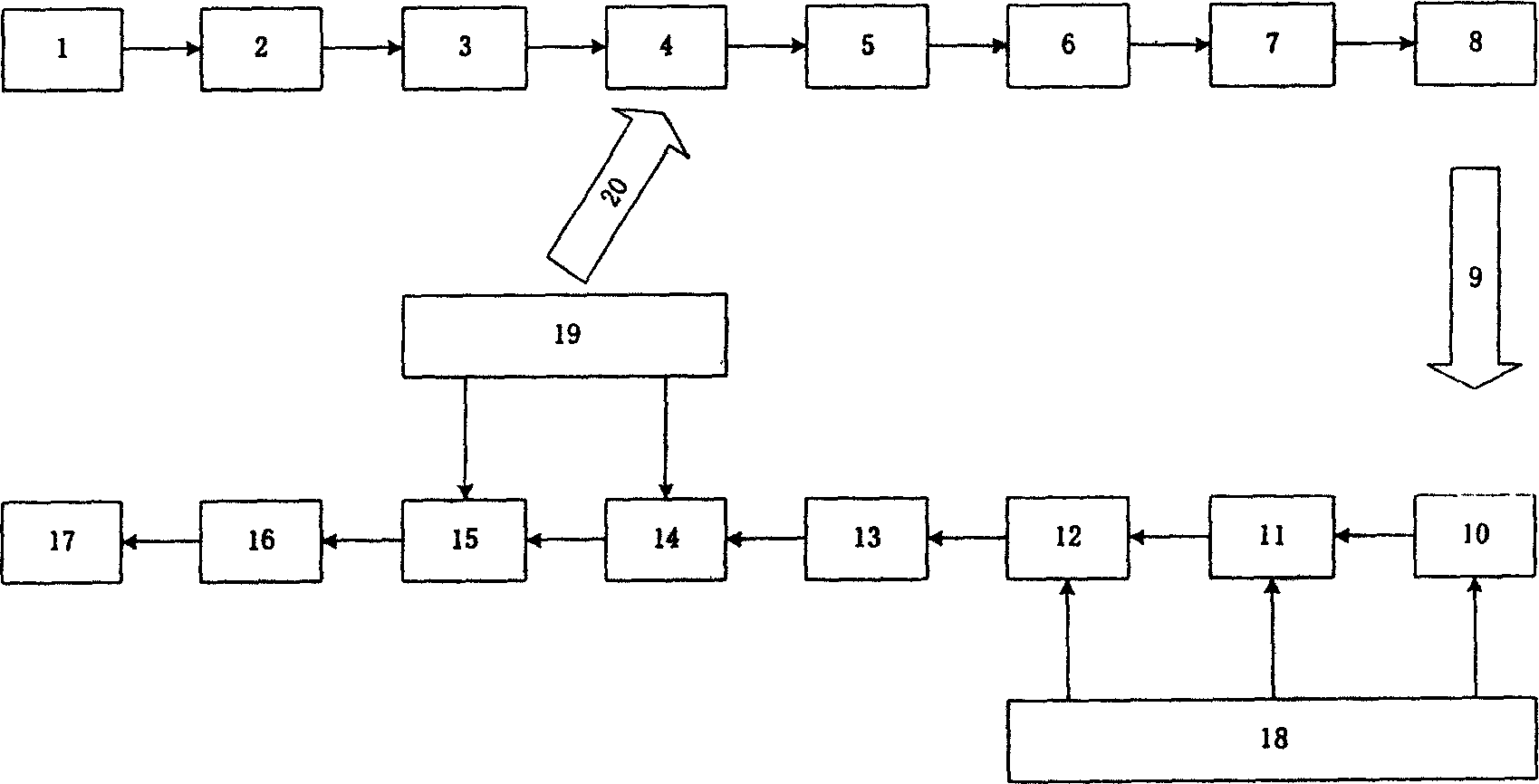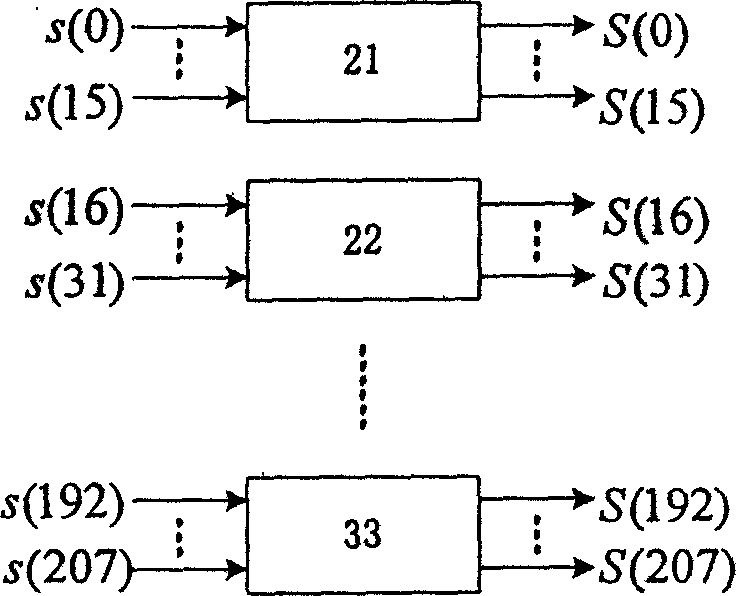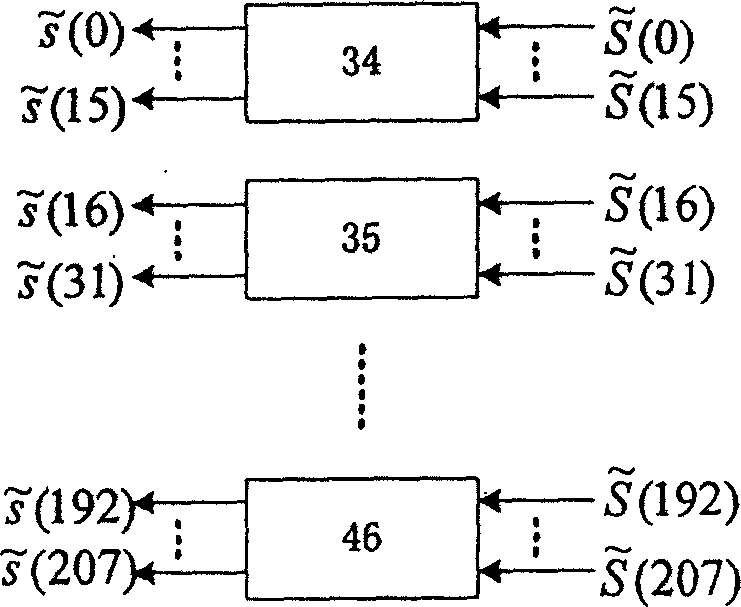Frequency selective mode single carrier blocking transmission method
A block transmission, single carrier technology, applied in transmission systems, digital transmission systems, modulated carrier systems, etc., can solve the problem that the sender cannot use it.
- Summary
- Abstract
- Description
- Claims
- Application Information
AI Technical Summary
Problems solved by technology
Method used
Image
Examples
Embodiment 1
[0095] figure 1 A block diagram of the SC-FDE system realized according to the present invention is given.
[0096] In the figure, except the signal spectrum transformation module 4 and the signal spectrum inverse transformation module 14, all other modules adopt common modules of the existing SC-FDE system, and the functions of each module are as follows:
[0097] Source module 1: Generates data to be transmitted.
[0098] Symbol mapping module 2: When the modulation mode is QAM or MPSK, map the data generated by the source to the corresponding point of the constellation diagram.
[0099] M-point FFT module 3: Transform the M mapped signals of each frame into the frequency domain to obtain the M-point frequency domain signals of the signal.
[0100] Signal spectrum transformation module 4: according to the subchannel label information sent back by the receiving end through the reverse channel, place the M-point frequency domain signal output by module 3 on the spectrum poin...
Embodiment 2
[0128] In this embodiment, the FFT (and IFFT) module in the system described in Embodiment 1 adopts segment processing—equal point segment. Replace the many FFT modules 3 of the number of points in embodiment 1 with the few FFT modules of some points (referring to figure 2 ), figure 2 21-33 in it is a 16-point FFT module.
[0129] For the simulation parameters of Embodiment 1, the number of useful sub-channels is selected as M=208, which is not an integer power of 2. Directly perform 208-point FFT calculation on the 208-point signal, and the calculation efficiency is low, so segment processing is adopted:
[0130] Take the points of each small segment as 16 (ie 2 4 ), so that a frame of 208 data s(n), (n=0, 1, ..., M-1) can be divided into 13 segments with 16 points, and each segment performs 16-point FFT operations (such as figure 2 In the module 21-33), get the frequency domain signal S(k), (k=0,1,...,M-1), such as figure 2 shown.
[0131] Receiver agrees to (k=0...
Embodiment 3
[0135] The FFT (and IFFT) modules in the system described in Example 1 are segmented - decrementing segments by powers of two. Replace the IFFT module 16 with many points in embodiment 1 with a few IFFT modules with few points (see image 3 ).
[0136] Still adopt the emulation parameter M=208 among the embodiment 1, non-integer power of 2, do not carry out equal number segmentation now, and adopt the method segmentation by the power of 2 decrement:
[0137]The transmitting end divides s(n), (n=0, 1, ..., M-1) into segments with points of 128, 64, and 16 respectively. The points of these segments are all integer powers of 2, and 128 , 64, the FFT operation of 16 points finally obtains the frequency domain signal S(k), (k=0, 1, . . . , M−1).
[0138] Receiver pair equalized signal (k=0, 1, ..., M-1) is divided into segments with 128, 64, and 16 points respectively, and IFFT operations are performed on them with 128, 64, and 16 points respectively, and finally the time domai...
PUM
 Login to View More
Login to View More Abstract
Description
Claims
Application Information
 Login to View More
Login to View More - Generate Ideas
- Intellectual Property
- Life Sciences
- Materials
- Tech Scout
- Unparalleled Data Quality
- Higher Quality Content
- 60% Fewer Hallucinations
Browse by: Latest US Patents, China's latest patents, Technical Efficacy Thesaurus, Application Domain, Technology Topic, Popular Technical Reports.
© 2025 PatSnap. All rights reserved.Legal|Privacy policy|Modern Slavery Act Transparency Statement|Sitemap|About US| Contact US: help@patsnap.com



